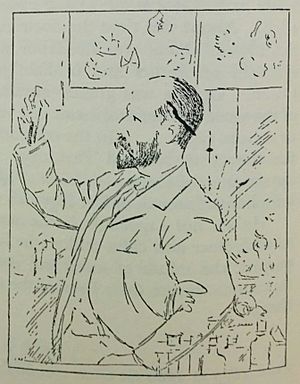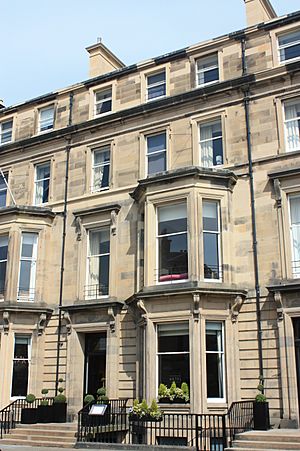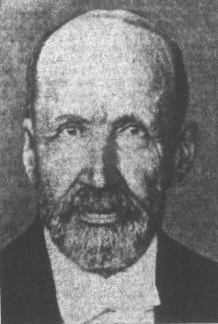John Alexander MacWilliam facts for kids
Quick facts for kids
John Alexander MacWilliam
FRS |
|
|---|---|
 |
|
| Born | 31 July 1857 Kiltarlity, Inverness-shire, Scotland
|
| Died | 13 January 1937 (aged 79) Edinburgh, Scotland
|
| Nationality | British/Scottish |
| Citizenship | United Kingdom |
| Alma mater | University of Aberdeen University College, London University of Leipzig |
| Known for | Research and discoveries in field of cardiac function (heart, arteries, blood pressure). |
| Awards |
|
| Scientific career | |
| Fields | Physiology, Cardiology |
| Signature | |
John Alexander MacWilliam (born 31 July 1857 – died 13 January 1937) was a very important scientist. He worked at the University of Aberdeen in Scotland. He was a pioneer in understanding how the heart works, especially its electrical signals.
MacWilliam spent many years studying a serious heart problem called ventricular fibrillation. This is when the heart's lower chambers (ventricles) just quiver instead of pumping blood. He was the first to suggest that this was a common cause of sudden death. He also thought that giving the heart electric shocks could stop this problem and save lives.
He was also the first to properly describe arrhythmia, which is an irregular heartbeat. He even suggested a way to restart a stopped heart (called asystole) using electric shocks.
Even though his work was recognized during his lifetime, it took many years for his ideas to be fully used. His research helped create modern treatments for serious heart conditions, like the artificial cardiac pacemaker. MacWilliam became a professor at the University of Aberdeen at just 29 years old in 1886. He stayed there for 41 years until he retired in 1927.
Contents
Early Life and Family
John Alexander MacWilliam was born on 31 July 1857. His family lived in Kiltarlity, a place near Beauly in Inverness-shire, Scotland. His father was a farmer at Culmill farm.
His parents were William McWilliam and Isabella Cumming. His mother, Isabella, was the youngest daughter of the people who started the Cardhu whisky distillery. John Alexander had an older brother, William Lewis McWilliam. His brother continued to farm at Culmill.
Around the late 1880s, John Alexander changed the spelling of his last name. He changed it from McWilliam to MacWilliam. His scientific papers published before 1889 used the older spelling.
Education and Early Studies
MacWilliam went to school in Kiltarlity. When he was 17, in 1874, he started at Aberdeen University. He first studied arts for two years. Then he switched to study medicine. He earned his medical degree in 1880. He also won a special award for his excellent achievements that year.
After Aberdeen, he continued his studies in other places. He worked at the University of Edinburgh and University College, London. He also worked with famous scientists like Carl Ludwig in Germany. Ludwig had invented a tool called the Kymograph. This machine could record heartbeats and muscle movements.
MacWilliam began his research by studying the hearts of cold-blooded animals. These included eels, fish, and frogs. He noticed that the electrical activity of their hearts was similar to human hearts. He then used his findings from these animals to understand human hearts. He believed that irregular heartbeats were a cause of sudden death. In 1882, he received his M.D. degree from Aberdeen University.
Groundbreaking Heart Research
From 1883 to 1886, MacWilliam worked at University College London. He worked with other important scientists there. In 1886, he became a professor at the University of Aberdeen. He was only 29 years old.
MacWilliam studied the muscles of the diaphragm and the heart. He published a paper about the heart of the eel. He described how the heart muscle contracts and how this process could be stopped or changed. He then extended his experiments to mammal hearts, often using cats. He found that what he learned from eel hearts also applied to mammal hearts.
He studied a condition called "Herz-delirium," which we now call "ventricular fibrillation." This is when the heart's muscles don't work together properly. He wanted to understand why this happened and how to make the heart beat normally again. He found a specific area in the heart where the contraction could be easily stopped. He also described "auricular flutter," another heart problem. He concluded that these problems were due to the heart muscle itself, not the nerves.
MacWilliam also described basic steps for cardiopulmonary resuscitation (CPR). This includes helping an animal breathe and pressing on its chest. These actions helped keep his experimental animals alive.
His work on heart electricity was very important. He described a method called transthoracic pacing. This was for treating a very slow heartbeat (bradycardia). He also suggested giving electric shocks to restart a heart that had stopped completely (asystole). He warned against using strong, constant electric currents. These could actually cause fibrillation.
MacWilliam also listed things that could trigger ventricular fibrillation. These included changes in blood pressure from exercise, certain medicines, and even chloroform. In 1887, he showed that chloroform, which was used for anesthesia, could directly affect the heart and cause ventricular fibrillation. This was important because chloroform was causing deaths during surgeries.
He also studied how dreams affect heart rate and blood pressure. In 1923, he reported that disturbed sleep could put sudden and dangerous stress on the heart. He thought that fibrillation could happen during sleep and dreaming, similar to how emotional stress affects the heart.
Even though he continued his research, MacWilliam focused more on teaching after becoming a professor in 1886. He retired in 1927 at the age of 70.
Many of his students at Aberdeen became very successful. One famous student was John James Rickard Macleod. He won a Nobel Prize in 1923 for discovering insulin. Macleod later took over MacWilliam's teaching position at Aberdeen.
Lasting Impact
It took more than 60 years for doctors to fully use MacWilliam's research. The first successful use of a defibrillator on a human was in 1947. The first successful use of transthoracic defibrillation was in 1956. Heart pacemakers became common in the 1950s and 1960s.
In the 1960s, patient care for heart problems greatly improved. This was thanks to CPR and special heart care units in hospitals.
Today, MacWilliam's work is highly praised. In 1989, a Harvard University researcher wrote that MacWilliam's methods laid the groundwork for modern heart research. He said MacWilliam provided the first complete way to successfully restart a heart. He also said MacWilliam's basic ideas have lasted for a century. They have greatly influenced heart research and treatment for many generations. In 1959, Dr. Bernard Lown invented a heart treatment based on MacWilliam's original work.
A professor named Hugh Maclean wrote in MacWilliam's obituary that "He lived thirty years before his time." He also said that "the value of his contributions can hardly be overestimated."
Honors and Recognition
MacWilliam received many honors for his important work.
- He was elected as a Fellow of the Royal Society (FRS) in 1916. This is a very high honor for scientists.
- He received an honorary degree (LL.D.) from Aberdeen University in 1927.
- He was a member of the University Court (the governing body) of Aberdeen University from 1917 to 1921.
- He was also a member of the University Senate from 1906 until his retirement.
At Aberdeen University, there is a special room named after him. It is called the MacWilliam Resuscitation Training Room. This room is used to teach people how to save lives.
The National Portrait Gallery in London has two photographs of him.
Personal Life
In 1889, when he was 32, MacWilliam married Edith Constance Wise. Sadly, Edith died in November 1893 from malaria. She caught the illness while traveling in the Canary Islands.
In 1898, he married for a second time to Florence Edith Thomas. She was a trained nurse. She had worked at famous hospitals in London and Oxford. In Aberdeen, she helped with social work, including caring for soldiers returning from World War I. MacWilliam lived in the village of Cults, near Aberdeen, for all his married life.
MacWilliam suffered from a stomach problem for much of his life. It was later diagnosed as a duodenal ulcer.
Death
John MacWilliam died of heart failure in January 1937. He passed away in a nursing home in Edinburgh. He is buried with his wives at Allenvale cemetery in Aberdeen.




